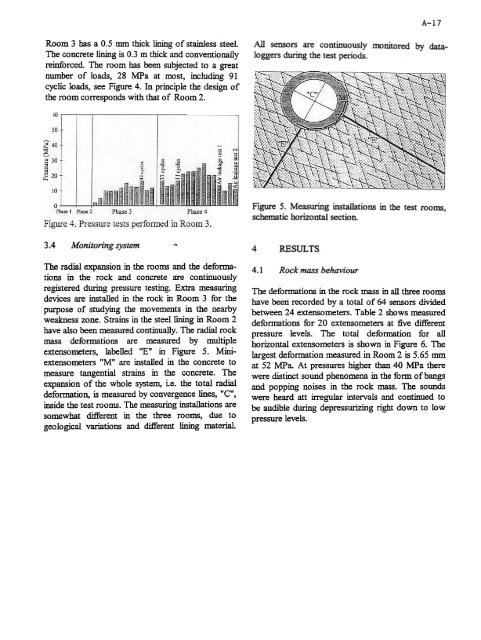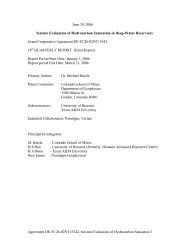Technical Review of the Lined Rock Cavern Concept and Design ...
Technical Review of the Lined Rock Cavern Concept and Design ...
Technical Review of the Lined Rock Cavern Concept and Design ...
Create successful ePaper yourself
Turn your PDF publications into a flip-book with our unique Google optimized e-Paper software.
Room 3 bas a 0.5 mm thick lining <strong>of</strong> stainless steel.<br />
The concrete lining is 0.3 m thick <strong>and</strong> conventionally<br />
reinforced. The room has been subjected to a great<br />
number <strong>of</strong> loads, 28 NfPa at most, including 91<br />
cyclic loads, see Figure 4. In principle <strong>the</strong> design <strong>of</strong><br />
<strong>the</strong> room corresponds with that <strong>of</strong> Room 2.<br />
3.4 Monitoring system<br />
The radial expansion in <strong>the</strong> rooms <strong>and</strong> <strong>the</strong> deformations<br />
in <strong>the</strong> rock <strong>and</strong> concrete are continuously<br />
registered during pressure testing. Extra measuring<br />
devices are installed in <strong>the</strong> rock in Room 3 for <strong>the</strong><br />
purpose <strong>of</strong> studying <strong>the</strong> movements in <strong>the</strong> nearby<br />
weakness zone. Strains in <strong>the</strong> steel lining in Room 2<br />
have also been measured continually. The radial rock<br />
mass deformations are measured by multiple<br />
extensometers, labelled "E" in Figure 5. Miniextenso<br />
meters "M" are installed in <strong>the</strong> concrete to<br />
measure tangential strains in <strong>the</strong> concrete. The<br />
expansion <strong>of</strong> <strong>the</strong> whole system, i.e. <strong>the</strong> total radial<br />
deformation, is measured by convergence lines, I'C",<br />
inside <strong>the</strong> test rooms. The measuring installations are<br />
somewhat different in <strong>the</strong> three rooms, due to<br />
geological variations <strong>and</strong> different lining material<br />
'.'<br />
A-I?<br />
All sensors are continuously monitored by dataloggers<br />
during <strong>the</strong> test periods.<br />
Figure 5. Measuring installations in <strong>the</strong> test rooms,<br />
schematic horizontal section.<br />
4 RESULTS<br />
4.1 <strong>Rock</strong> mass behaviour<br />
The deformations in <strong>the</strong> rock mass in all three rooms<br />
have been recorded by a total <strong>of</strong> 64 sensors divided<br />
between 24 extenso meters. Table 2 shows measured<br />
deformations for 20 extenso meters at five different<br />
pressure levels. The total defonnation for all<br />
horizontal extenso meters is shown in Figure 6. The<br />
largest deformation measured in Room 2 is 5.65 mm<br />
at 52 l\I1Pa. At pressures higher than 40 l\I1Pa <strong>the</strong>re<br />
were distinct sound phenomena in <strong>the</strong> form <strong>of</strong> bangs<br />
<strong>and</strong> popping noises in <strong>the</strong> rock mass. The sounds<br />
were heard att irregular intervals <strong>and</strong> continued to<br />
be audI"ble during depressurizing right down to low<br />
pressure levels.

















